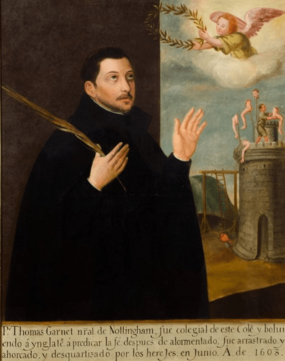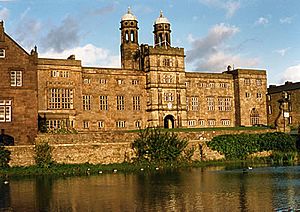Thomas Garnet facts for kids
Quick facts for kids SaintThomas Garnet S.J. |
|
|---|---|

Portrait from the Royal English College in Valladolid
|
|
| Martyr | |
| Born | 9 November 1575 Southwark, Central London, England |
| Died | 23 June 1608 (aged 32) Tyburn, Middlesex, England |
| Venerated in | Roman Catholic Church |
| Beatified | 15 December 1929 by Pope Pius XI |
| Canonized | 25 October 1970 by Pope Paul VI |
| Feast | 23 June (individual) 25 October (with Forty Martyrs of England and Wales) |
| Attributes | Martyr's palm |
Thomas Garnet (born November 9, 1575 – died June 23, 1608) was a Jesuit priest. He was executed in London because of his faith. He is known as the first martyr from Saint Omer and Stonyhurst College. Thomas Garnet was executed at Tyburn. He is one of the Forty Martyrs of England and Wales.
Contents
A Young Life: Early Years and School
Thomas Garnet was born in Southwark, England. His family was well-known. His uncle, Henry Garnet, was a leader of the Jesuits in England. Thomas's father, Richard Garnet, studied at Balliol College, Oxford. At that time, Catholics faced harsh treatment. His father's example inspired many other English Catholics.
Thomas went to Collyer's School in Horsham. Later, he worked as a page for a relative of Philip Howard, Earl of Arundel. This relative, however, followed the Anglican faith.
Because English colleges were taken over by Protestants, many English Catholics went to Europe for their education. In 1593, at age 17, Thomas was among the first students at Saint Omer's Jesuit College. This college later moved to Stonyhurst in 1794.
By 1595, he was ready for the new English seminary, Saint Albans, in Valladolid, Spain. He set out from Calais with five other students.
Captured at Sea
Thomas and his friends were lucky to find a Jesuit Father William Baldwin traveling with them. Father Baldwin was disguised as someone else. But soon, problems began. After a bad storm in the English Channel, their ship had to find shelter.
Their vessel was searched by sailors from Queen Elizabeth's ships. Thomas and his friends were found hiding. They were immediately taken prisoner and treated very roughly. They were sent to London and questioned by the Lord Admiral.
Father Baldwin's Difficult Choice
After this, Father Baldwin was sent to Bridewell prison. There, he met a man named James Atkinson. Atkinson had given away names of other Catholics under torture. He felt terrible and feared being tortured again. He worried he would die without being forgiven for his betrayals.
This put Father Baldwin in a tough spot. Was Atkinson a spy trying to trick him into admitting he was a priest? In the end, Baldwin decided to hear Atkinson's confession. Atkinson was filled with joy after being forgiven. Later, Atkinson was tortured again and died.
Escaping Custody
Meanwhile, Thomas and his young friends were given to Archbishop Whitgift. He was the Archbishop of Canterbury. He saw that the boys encouraged each other. So, he sent them one by one to different Protestant leaders.
Only the youngest boy, Mompesson, changed his faith. The others eventually escaped. They returned to their colleges in Europe after many adventures. We don't know exactly what happened to young Garnet. But it seems he was held at the home of Richard Edes. He became sick and was sent home. He was supposed to return to custody later.
But Thomas escaped again. To avoid trouble, he had to stay away even from his own father. Finally, he reached Saint Omer again. Then, in 1596, he went to Valladolid after many exciting escapes.
Returning to Danger in England
After becoming a priest in 1599, at age 24, Thomas Garnet returned to England. He said he "wandered from place to place." His goal was to help people who were lost and mistaken about the true Catholic Church.
In 1605, there was a lot of excitement because of the Gunpowder Plot. Thomas was arrested near Warwick. He was using the name Thomas Rokewood. He likely took this name from Ambrose Rokewood, whose chaplain he was. Unfortunately, Ambrose Rokewood was involved in the plot.
Time in Prison
Garnet was first imprisoned in the Gatehouse. Then he was moved to the Tower of London. He was tortured there. The authorities wanted him to give evidence against his famous uncle, Henry Garnet. Henry Garnet was the leader of the English Jesuits. He had recently allowed Thomas to join the Jesuit order.
The authorities suspected Henry Garnet was involved in the Gunpowder Plot. He was later executed because of this suspicion. Even though no link to the plot could be proven against Thomas, he stayed in the Tower of London for seven months.
After this, he was suddenly put on a ship with 46 other priests. A royal announcement was read to them. It warned them they would die if they returned to England. They were then taken across the Channel and left in Flanders.
Back to Europe, Then Back to England and Martyrdom
Garnet went back to his old school at Saint Omer. Then he went to Brussels to see Father Baldwin. Baldwin was the Jesuit leader and his companion from their adventures in 1595. Father Baldwin sent him to the English Jesuit novitiate (a place for new members) in Leuven. Thomas was the first new member received there.
In September 1607, he was sent back to England. But just six weeks later, he was arrested by a former priest named Rouse. This was during a time when King James was arguing with Cardinal Bellarmine. The argument was about the Oath of Allegiance.
Garnet was offered his life if he would take the oath. But he bravely refused. He was executed at Tyburn at the age of 32. He said he was "the happiest man this day alive." His relics (special items connected to him) were kept at Saint Omer. But they were lost during the French Revolution.
St. Thomas Garnet's Independent School in Boscombe, Bournemouth, was named after the saint when it was founded. It closed in 2020.


